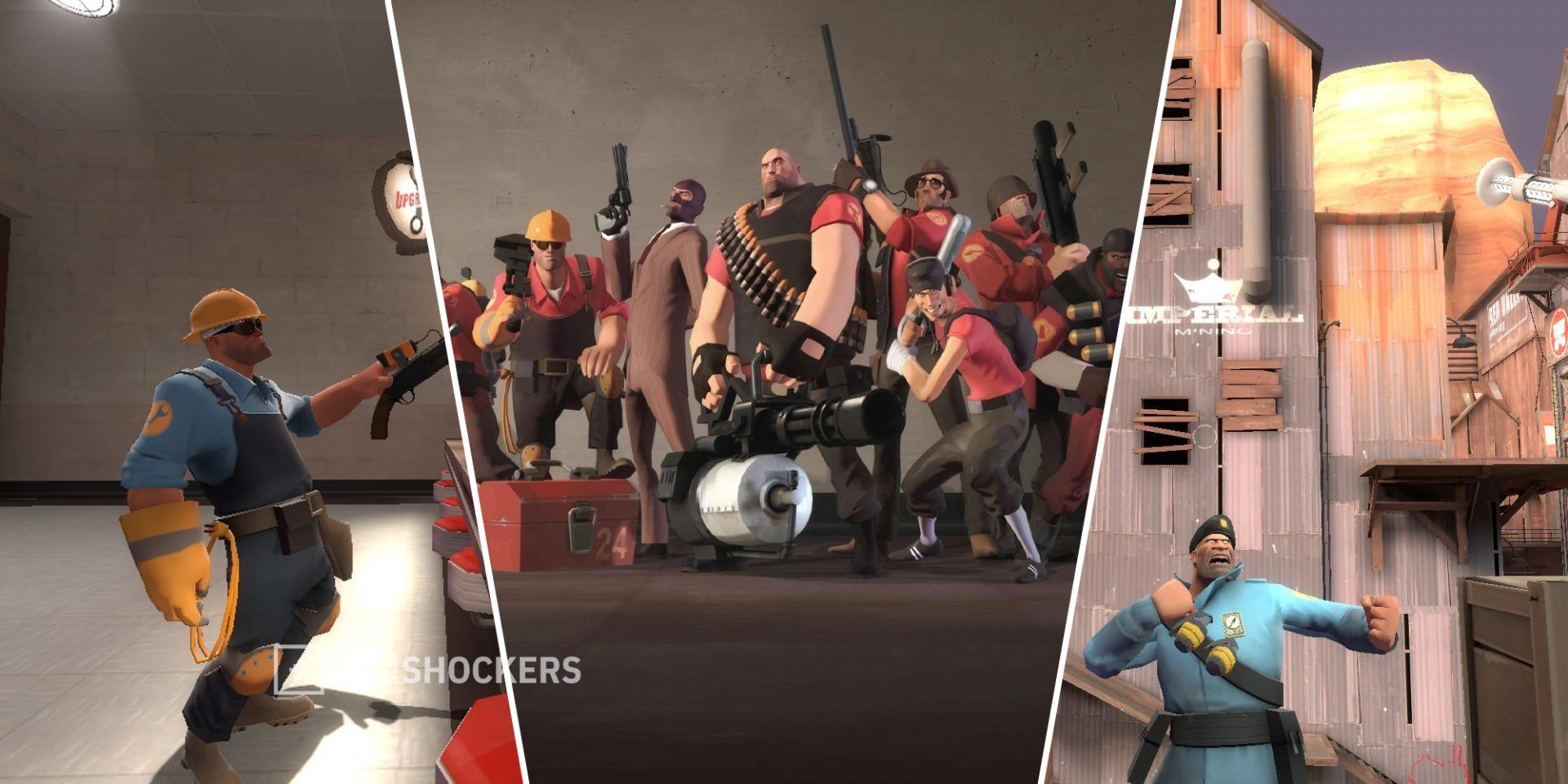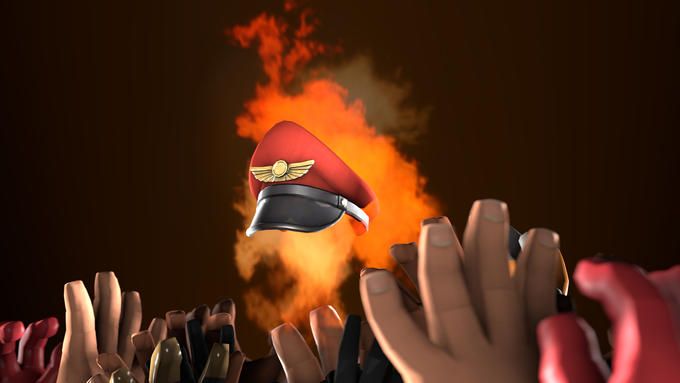Team Fortress 2 had a long road to its famous 2010 ‘Mann-conomy’ update, which kickstarted the game's economy through the addition of microtransactions. The sequel to the original 1999 Half-Life mod Team Fortress went through development hell, completely shifting design in the mid-2000s before releasing with the Orange Box in 2007. The class-based FPS went through plenty of changes in the three intervening years. This included things like adding the Pyro’s ability to airblast, the Engineer being able to pick up buildings, and even the Demoman having his Grenade Launcher ammo count reduced from 6 shots to 4 (yes, the Grenade Launcher having 6 barrels was actually accurate at one time).
But the biggest change to Team Fortress 2 came in the form of cosmetics.
This ended up having huge ramifications for the game itself, and the industry at large. Team Fortress 2 added the first nine hats to the game during the Sniper vs Spy update on May 21, 2009. After every class in the game had received their first cosmetic item, the dynamic of the game changed. Prior to this, unlockable weapons were tied to in-game achievements, meaning that the only way to get these new weapons was to play the game. After this update, items would randomly drop every so often, with the chance of a hat being one of them. Past the cool factor of being one of the few to get a rare drop and being one of the few to wear a hat, there was not much to the system. Other than buying someone’s Steam account from them, there was no way to transfer these hats between players. All this changed with the Mann-conomy update.
TF2's initial Mann-co Store
On September 30, 2010, Valve released the Mann-conomy update for Team Fortress 2. It added many things, including trading, an in-game store, and Unusual Effect Hats - regular cosmetics that had a new effect on top of them, such as ‘Burning Flames’ that made the hat look like it was on fire, or ‘Sunbeams’, which had hats give off rays of light. An in-game trading system now allowed players to trade items, such as weapons or cosmetics, between one another. This allowed an in-game economy to form, as players did not know what items would be most sought after once this system had been implemented.
While the game now has many great online resources such as backpack.tf or scrap.tf to quickly trade and look up the value of items, these websites did not exist until many years after this update. Prior to a stable economy forming, many players would trade their items for far below their value because of this. The eight-item cap for each trade also limited how high prices could go. The only resource for pricing was the ‘TF2 Trade Value Spreadsheet’, a website that hosted a frequently changing list of item values. This spreadsheet was being heavily manipulated by a handful of people in the community who would change prices based on what they were buying or selling at the time, leading to values jumping around constantly.
Valve’s idea was that their new in-game Mann-Co Store would help stabilize prices. After this update, Valve would allow players to spend money in order to unlock in-game items like weapons or cosmetics. This system also introduced the Mann-Co Supply Crates and keys. Crates would drop frequently to players over time, and the store would sell the keys needed to open them for $2.49. While nowadays there is a variety of 'strange weapons' (weapons that counted your kills with that weapon) and taunts that can be obtained by opening crates, the first few series of crates only offered the chance to drop regular weapons. After months of complaints, Valve introduced Strange Weapons to replace them starting with the Series 19 crates on June 23, 2011, the update that also made the game free to play forever.
Unusual Hats were fast becoming a lucrative item too. Nobody at the time really understood just how expensive and sought after these rare hats were going to be. Back in 2010, the early Unusuals were selling for about eight regular hats. Nowadays, some of these Unusuals sell for thousands of dollars. The most famous of these is the Burning Team Captain - the flame effect added to the hat modelled after M. Bison from Street Fighter. While this hat isn’t even the rarest in the game, it has always been perceived as being the most sought after. The highest sale for a Burning Flames Team Captain was around $20,000.
The infamously expensive Burning Team Captain hat.
While the popularity of Team Fortress 2 climbed significantly from this point forward, due in large part to the game going free to play on June 23, 2011, the game’s dynamic was permanently changed after this update. The well-balanced dynamic between the game's nine classes was once the pull for Team Fortress 2, but the cosmetics market became the big draw. While Valve initially had strict cosmetic rules based on those that fitted with the game’s art style at the beginning, that soon went out the window. After this point the game added even more ridiculous cosmetics, such as a set that made the Engineer class fat or a unicorn hat that coincided with the massive popularity of My Little Pony at the time.
Nowadays, this TF2 trading system is completely integrated through Steam rather than just Team Fortress 2. This new system led to Valve introducing it across the board for games such as Counter-Strike or Dota 2. This initial period saw the market correct itself for the first time, with key prices dropping to just over $1 a piece. While players who wanted to sell their stockpiled keys from trading before had to run the risk of being scammed when attempting to be paid with real-world money, the Steam Market now allowed them to run these sales through a middle-man for money they could use through their account safely.
Today, the idea of a mystery item being unlocked for spending money is incredibly commonplace in games like Madden, FIFA or even Overwatch, but Team Fortress 2 was the game that got the ball rolling. EA Sports first introduced the concept of a mystery item with FIFA 09 (in their case, card packs for their Ultimate Team game mode). While this concept had caught on fairly quickly for FIFA players in Europe, the same system took a few years to catch on with Madden and other games. Following Team Fortress 2’s massive success after the Mann-conomy Update, games like Fortnite were able to make substantial money selling optional cosmetic items to players for a fee. Fortnite, now one of the biggest games in the world, could never have found success as a free-to-play title if it were not for Valve setting the standard.
Assuming that microtransactions were going to become a phenomenon sooner or later, it has probably been a good thing for the industry that Valve was the one to set the standard. Had it been a company like EA or Activision, it’s possible that in-game transactions that heavily affect gameplay and change the core experience would have become the norm. Nowadays, most microtransactions are limited to superfluous in-game items worn purely for fashion purposes. Love them or hate them, they're relatively unintrusive to most players, making them a price worth paying for many F2P games today.



